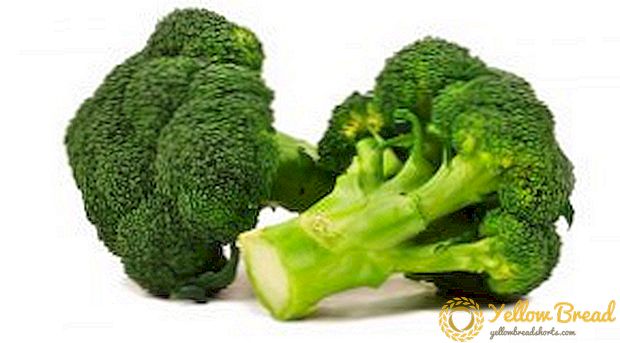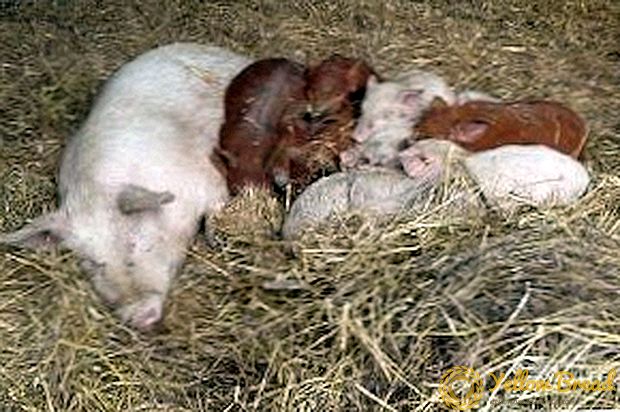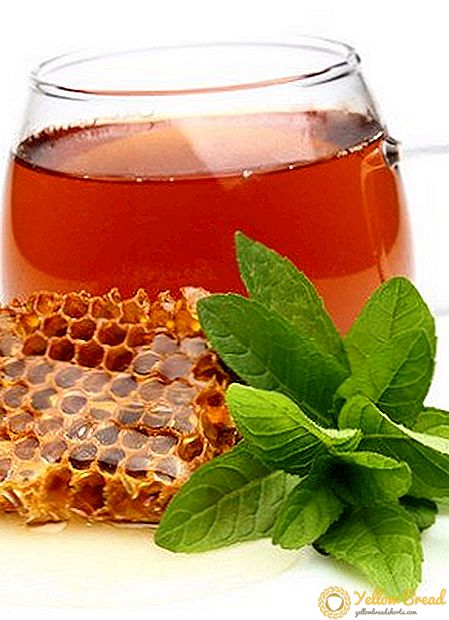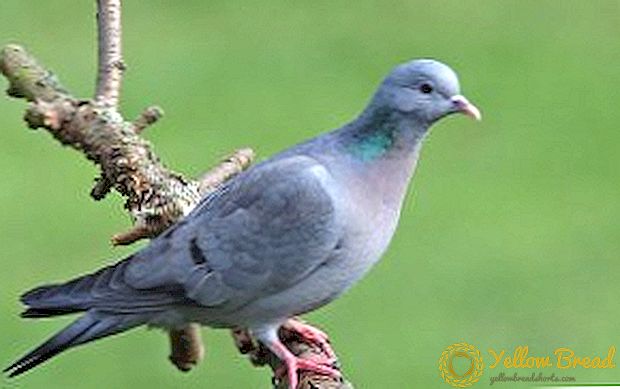 Today there are many ways to harvest broccoli for the winter. Some of them are designed to preserve as much of the beneficial properties of cabbage, others - to prepare for further use in the composition of other dishes, and still others generally represent a separate dish. Such diversity will allow each hostess to choose a way that meets her needs, opportunities and mood. In addition, homemade preparations will preserve the usefulness of the diet all year round.
Today there are many ways to harvest broccoli for the winter. Some of them are designed to preserve as much of the beneficial properties of cabbage, others - to prepare for further use in the composition of other dishes, and still others generally represent a separate dish. Such diversity will allow each hostess to choose a way that meets her needs, opportunities and mood. In addition, homemade preparations will preserve the usefulness of the diet all year round.
- Broccoli selection
- How to freeze?
- Dried cabbage
- Drying in the oven
- Electric Drying
- Pickling
- Broccoli Salads
- Broccoli with chicken
- Broccoli with crab sticks
- Chinese broccoli
- Broccoli and Apple Salad
- Broccoli and Mozzarella Salad
Broccoli selection
Choosing vegetables, we are guided by a mental standard that dictates to us what a particular vegetable should be, what we should pay attention to.  For broccoli, these parameters are as follows:
For broccoli, these parameters are as follows:
- Colour. The first thing that catches your eye is a rich green color. A light vegetable, most likely, has not yet ripened, and yellowed tops are a sign of over-ripening. These green broccoli caps make a high content of beta-carotene, which is in the maximum quantities found in ripe vegetables.Also, the dark purple hue of the tops of the heads will change to green when cooked.
- Elasticity. The broccoli you need should be elastic: have hard petioles and a dense cap. The yellow specks on the tops of the heads are a sign of the onset of wilting, and soft, pliable legs indicate that the vegetable is no longer edible.
How to freeze?
With the advent of refrigerators with bulk freezers in every home, the freezing method has become popular.
This way of storing vegetables really has a number significant benefits:
- Frozen vegetables and fruits retain maximum nutrients and are always ready to eat.
- The simplicity of the process. Freedom from all kinds of sterilization and boiling dishes.
- Availability. Frozen fruits and vegetables under the force of even a child.
 How to freeze broccoli at home? Before you put the vegetable in the freezer, you need to to prepare:
How to freeze broccoli at home? Before you put the vegetable in the freezer, you need to to prepare:
- To begin with, wash the broccoli under running water and make sure that there is no dirt, garbage, parasites, etc. left on the vegetable. If you find any insects, it is best to immerse the cabbage in a saline solution for 30 minutes in order to completely remove them. Put the cabbage in the water you need to head down, and the solution is prepared at the rate of 3 tbsp. l salt to 1 liter of warm water.
- After the insects have been removed, you can once again rinse the cabbage to wash off the remnants of salt water. If there were no insects, go to the next item.
- We divide inflorescences into parts convenient for you. The most convenient broccoli inflorescences are divided by stalks, separating with each part of the head of the desired size.
- After the vegetable is washed and chopped, it is time to cook it. It usually means two minutes boiling or steaming (in a double boiler) for 5 minutes. To blanch the vegetables you need to immerse in the already boiling water - this will save more vitamins and the appearance of the vegetable.
- After the time the cabbage must be removed and dried on a paper towel until the moisture from its surface completely disappears. During the freezing of a vegetable, and so will release a certain amount of moisture,which will turn into ice, damaging the walls of the plant.
- After the inflorescences dry and cool, it's time to start freezing. Ideally, a quick freeze function is used for this purpose, but you can do without it. For convenience, divide all the number of inflorescences available into portions of this size that you plan to use at one time. Otherwise, it will be necessary to either defrost the entire available mass, or to chop the pieces of the right size, damaging and breaking the inflorescences.
- It is better to place vegetables for freezing in a separate freezer drawer, as they are quite easily soaked with smells of other products. During the process, the temperature in the freezer should be from -18 ° C to -25 ° C.

Dried cabbage
Another way of harvesting vegetables - drying. Previously, fruits and some berries were mostly dried, now this method is more widely used.When drying, all moisture is removed from vegetable tissues, which prevents any processes of deterioration and rotting, as well as the appearance of mold.
At observance in the dryer of the temperature regime (about 50 ° C), broccoli retains all its beneficial properties and with further consumption as food is not inferior in this respect to fresh cabbage. Dried cabbage will be an ideal addition to the first and some main dishes. When cooking, the vegetable will restore all the lost moisture, and the cook should remember this, respecting the proportions.  There are two most affordable ways to dry cabbage: in the oven and in the electric dryer.
There are two most affordable ways to dry cabbage: in the oven and in the electric dryer.
Drying in the oven
Drying cabbage in the oven is carried out as follows:
- First you need to prepare the head, washed and disassembled it into small florets. It should be remembered that the larger the inflorescence, the longer it will take to dry, and the lower the temperature must be set in the oven.
- Next, prepare a baking sheet: lubricate the bottom with vegetable oil or line it with baking paper. You can also use silicone mats for rolling dough.
- Place the broccoli pan in the cold oven and set the temperature in the range from 50 to 80 ° C.To dry vegetables, you need to select the "convection" mode on the control panel of the oven, this will provide the necessary air circulation.
- The drying time takes about 4-5 hours, depending on the technical features of the oven and the quality of the cabbage.
- After the specified time inflorescence can be checked for readiness.
Signs of broccoli readiness:
- inflorescences decreased almost three times;
- acquired a slightly yellowish tint;
- when squeezing the inflorescences with the fingers, juice does not stand out from them.

Electric Drying
Working with an apparatus adapted for certain tasks is much simpler and requires less responsibility and skills. In the case of using an electric drier, the culinary specialist is only required to prepare the cabbage correctly, place it on a pallet and set a suitable mode, which can be easily calculated using the instructions.
If for some reason it is not possible to select the mode, the temperature and time can be set manually (50-80 ° С / 4-5 hours).
Pickling
There are many recipes for broccoli rolls: pickled cabbage goes well with a variety of spices and vegetables such as Bulgarian and hot peppers, onions, zucchini, etc. Marinated broccoli will be appreciated by those that it does not like in other forms.
It is no secret that many eat broccoli without great pleasure, ignoring all the beneficial properties. Marinade will give a spicy taste and aroma to a fresh vegetable. Of the minuses of seaming for the winter, it can be noted that the vegetable loses more in vitamins during a more thorough heat treatment than, for example, during freezing.  We will understand how to pickle broccoli without additives, while retaining the maximum of useful properties and beautiful green color.
We will understand how to pickle broccoli without additives, while retaining the maximum of useful properties and beautiful green color.
For the marinade required (ingredients per liter of water):
- 1 clove of garlic;
- 1 pod of hot pepper;
- 1 tsp dill seeds;
- 2-3 bay leaves;
- 1 tsp dried cumin;
- 2-3 art. l salts;
- 2 tbsp. l sugar;
- 100 ml. vinegar;
- 500 g gooseberry;
- 1 kg of fresh broccoli;
- 1000 ml of water.
Preparing broccoli for pickling is standard and detailed in the section “How to freeze?”, And we will look at how to cook pickle:
- Chop garlic. The smaller the pieces, the brighter the garlic taste will be felt.
- Then grind the pod pepper and greens.
- We wash the cabbage washed and divided into florets in a mixture of gooseberry and garlic, then prepare the container for pickling.
- Dill seeds, laurel and cumin are laid on the bottom of a jar or other container.
- We place inflorescences rolled in a mixture of greens and garlic in a jar on top of the dry ingredients.
- Add 100 ml of vinegar.
- Boil the water and dissolve the sugar and salt in it, then pour the cans with water so that the water completely covers the cabbage.
 Sterilization of dishes can be carried out together with its contents. To do this, for 5 minutes, place the jars of cabbage in the oven at 120 ° C. If sterilization will be carried out immediately after the contents have been poured with boiling water - the banks can be placed in an already heated oven, but if the banks have time to cool down - in the cold.
Sterilization of dishes can be carried out together with its contents. To do this, for 5 minutes, place the jars of cabbage in the oven at 120 ° C. If sterilization will be carried out immediately after the contents have been poured with boiling water - the banks can be placed in an already heated oven, but if the banks have time to cool down - in the cold.After sterilization, you can roll up the covers and place the seals in a warm blanket.
Broccoli Salads
We will look at 5 recipes in which broccoli is the main ingredient, and other ingredients are easily found in every home. The top five will include salads combining broccoli with meat, fresh vegetables, cheese and fruit.
Broccoli with chicken
Calories per 100 grams - 286 kcal.  Ingredients:
Ingredients:
- 2 pcs. chicken fillet;
- 1 small broccoli head;
- 200 gr. spicy hard cheese;
- mayonnaise dressing for dressing;
- salt;
- pepper (to taste).
Cooking:
- Boil chicken breast and broccoli until cooked.
- Chicken meat can be torn with the hands in the direction of the fibers, and the cabbage break into small florets.
- Grate cheese on a beet or carrot grater and add to meat and cabbage.
- Season salad dressing and spices.
- For sharpness, you can add a little finely chopped or even onions ground in a blender. But this is optional.
Broccoli with crab sticks
Calories per 100 g - 170 kcal.  Ingredients:
Ingredients:
- 200 g of crab sticks;
- 300 g broccoli;
- 100 g of green onions;
- 50 grams of cheese;
- 2 pcs. tomatoes;
- 4 tbsp. l sour cream;
- salt pepper.
Cooking:
- Broccoli boil.
- Cut the tomatoes into cubes and divide the cabbage into florets. Petioles chopped.
- Grind crab sticks, put all the ingredients together.
- Grate the cheese and add to the salad.
- Dress the salad with sour cream and spices.
Chinese broccoli
Calories per 100 g - 232 kcal.  Ingredients:
Ingredients:
- 700 g broccoli;
- 300 g carrots;
- 3 cloves of garlic;
- 1 chili;
- 10 g sesame seeds (to taste);
- salt;
- sunflower oil for refilling
Cooking:
- Disassemble the cabbage into inflorescences, cut stalks and boil in boiling water for 5 minutes.
- Grate the carrots on a beet grater or coarse straw and brown in a frying pan.
- Chop garlic and pepper.
- Combine the ingredients together and fill with sesame or sunflower oil, if desired, add salt.
Broccoli and Apple Salad
Calories per 100 g - 290 kcal.  Ingredients:
Ingredients:
- 400 g broccoli;
- 1 red apple;
- 40 g almonds;
- 1 clove of garlic;
- 1 white onion;
- 2 tbsp. lemon juice;
- 2 tbsp. l olive oil;
- ground pepper.
Cooking:
- Boil and disassemble the cabbage as usual.
- Apple cut into thin slices.
- Almonds interrupted in a blender or grind with a kitchen hammer. The fraction of nuts should be large enough.
- Finely chop the garlic.
- Onion cut into medium cubes.
- Mix the ingredients together and season with spices, oil and lemon juice.
Broccoli and Mozzarella Salad
Calories per 100 g - 362 kcal.  Ingredients:
Ingredients:
- 1 head broccoli;
- 200 grams of green peas;
- 2 tbsp. l pine nuts;
- 150 g of mozzarella;
- 4 tbsp. l olive oil;
- 2 tbsp. l rice vinegar or 1 tbsp. l dining room;
- 1 chili pepper.
Cooking:
- Boil the cabbage and green peas.
- Cut mozzarella into thin slices or strips.
- Combine cabbage and cheese with sliced pods, nuts and pepper, then season with vinegar and oil.
As you can see, healthy foods can also be delicious. By spending very little time, you can easily create new habits in food and in life. Eat right, love yourself and be healthy! Bon appetit!






